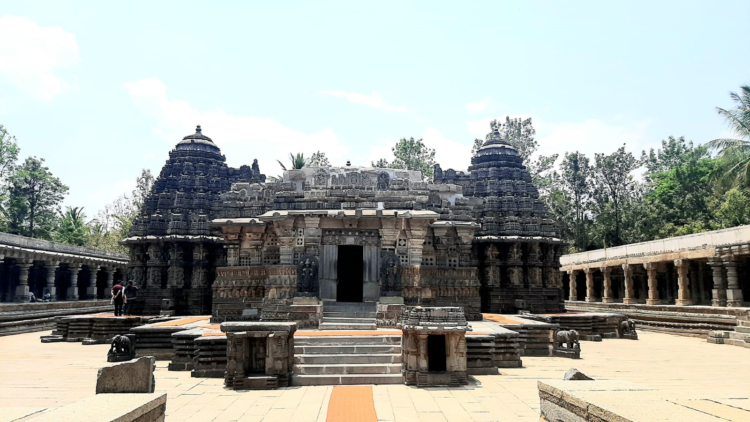The Chennakeshava Temple, tucked in the tranquil village of Somanathapura, is a visual feast for art and architecture enthusiasts. I visited this temple in May of last year. It is nearly 136 km from my house in Bengaluru. Reached Somanathapura around 11.00 AM. There is so much history here, so we decided to hire a guide. When you come here, don’t simply see; attempt to feel and visualize while the guide shows you around and narrates about the site.
Take with me a trip down memory lane as we travel through the Hoysala age with stories of grandeur gone.
Here’s the gist regarding the place:
Chennakeshava means Handsome Keshava. This temple was built in the 13th century by Somanatha Dandanayaka, a general of the Hoysala Kingdom during the reign of King Narasimha III. The temple is amazing for its intricate architecture and sculptures, inscriptions and history. An aerial view of the temple will show the structure of the temple in the form of a star which is surrounded by a pillared corridor of shrines and stones.
It is an architectural wonder that is highly incredible. This ancient temple has been a mute witness to many wars, and invaders that plundered the wealth of this temple. A few parts of this great temple were reconstructed many times after its destruction.
Chennakeshava is a Trikuta Vaishnava temple. It had 3 primary shrines – Lords Keshava, Janardhana and Venugopala. As of today, we can see only 2 shrines, the main shrine of Lord Kesava was stolen. Currently, no puja is offered to these shrines as these are “khandit murthies”, which means broken/damaged. In Sanatana dharma, such idols are not worshipped. Once a bustling religious place of magnum opus is now just a shadow of its past glory.
This temple’s architecture is a beautiful amalgamation of Nagara (North Indian) and Dravidian (South Indian) Style. The whole temple is made with soapstone brought from the Tumukur district. These stones are easy to carve when they are in water and become hard when out of water.
The depictions on the carvings include scenes from Ramayana, Mahabharata and Bhagavatam Purana legends in the correct sequence.The Outer walls of the mantapa have various figurines like miniature deity reliefs ,common life scenes, couples, some in sexual scenes, Krishna with flute, humans and cows listening, Standing Lakshmi and Vishnu, Mohini, Dancing Ganesha with sweets, Kama with sugarcane stalk, Saraswati with the Vedas and her alapini veena
The striking aspect of the temple is the ceiling showcasing different stages of lotus flower blooming. Below the beautiful carvings, one can also see the signature of the artist.
Several carvings have been ruined throughout multiple invasions.
Today, this temple stands as a UNESCO World Heritage nominee. The Chennakeshava Temple is not just a structure of stone; it’s a portal to a bygone era. Invasions and plunders have weathered its state, yet it stands as a masterpiece of intricate craftsmanship. As the guide’s narration ended, an odd sadness seeped inside me. So much is shattered, yet so much beauty exists. My mind couldn’t conceive what it would have looked like when the entire place was at its peak glory. It’s a tour that will not only astound you with its architectural grandeur, but will also nurture your soul, leaving you feeling grounded and invigorated.
My dear readers, the information shared above is only a portion of what I saw and the tour guide’s commentary as I recall.




